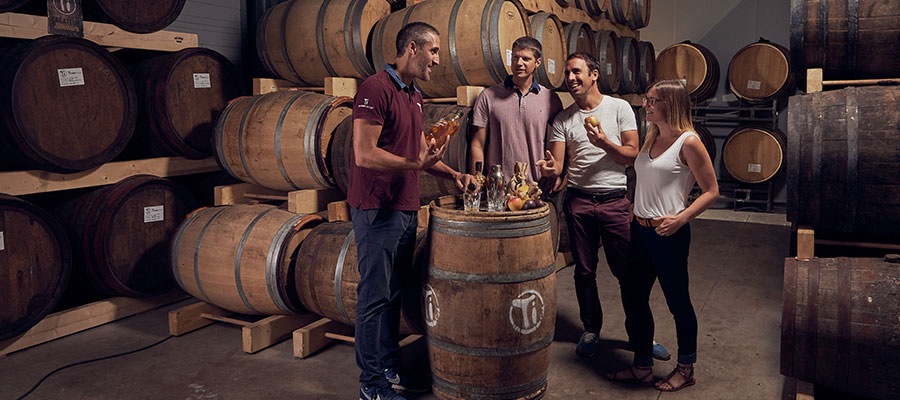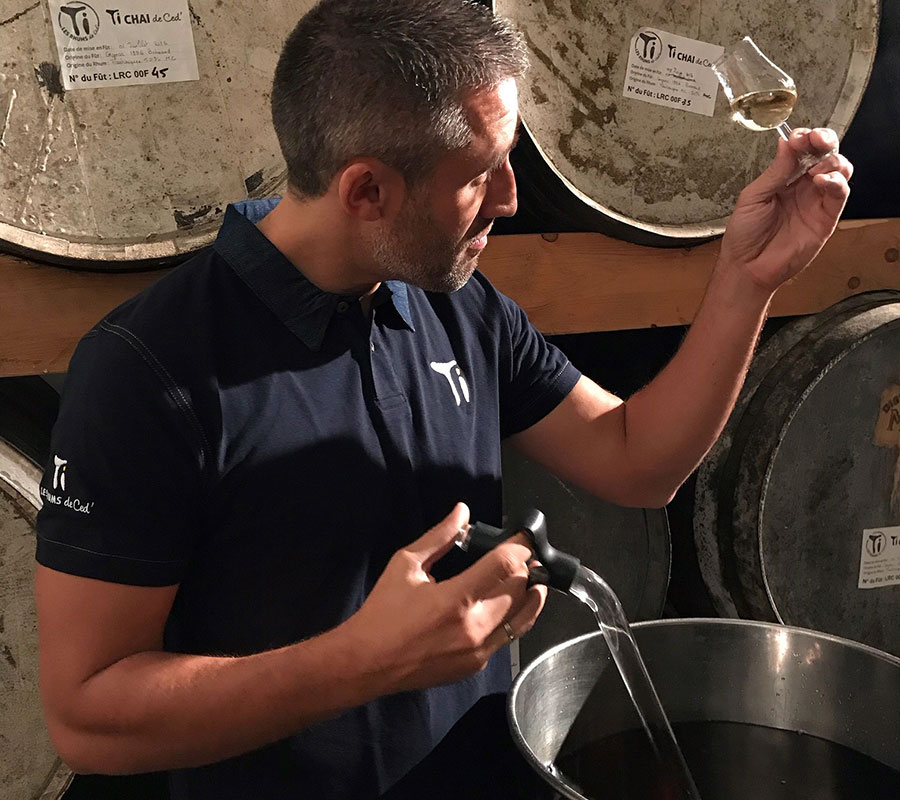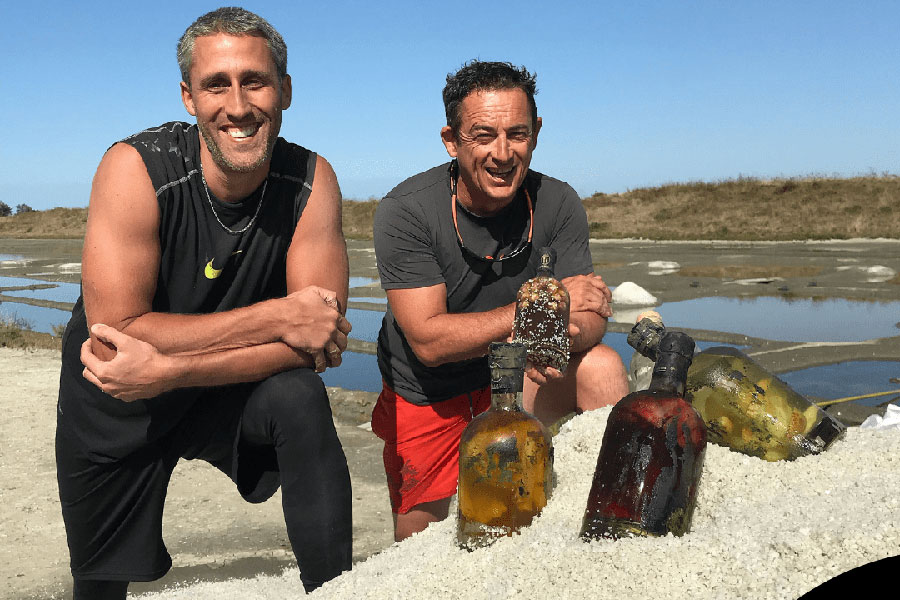Ti’Arrangés de Ced, a true model company in the rhum arrangés sector, was founded by Cédric Brément ten years ago and is now part of the Dugas group, the biggest distributor of super premium rums in mainland France. Let’s meet one of the important figures of this rum-filled decade!

Alexandre Vingtier: Cédric, you are celebrating 10 years since the creation of your brand, Ced’s Rums, what do you remember about this adventure?
Cédric Brément :When you stick to your values, which are shared by your employees, it allows a company to last over time. I have always tried to respect the tradition of agricole rums and ancestral recipes. It is a part of the history of rum for which I have a lot of respect.
Besides, it is a very French tradition. It existed in the former British or Spanish colonies, but it has not taken hold in the cities.
Yes, you are right, we realize on the international markets that consumers are not necessarily used to seeing pieces of fruit in rum. There is a job of explanation to be done.
Can you tell us where Ced’s rums stand in a few figures, 10 years after their birth?
We will finish the year 2021 with a production volume of 600,000 bottles, all handmade. We have tried over 250 different recipes since the creation of the brand. Whether it is on volumes of 20 or 15,000 bottles. Today we have 14 employees (knowing that all the commercial part is managed by Dugas, who bought 100% of my activity). The turnover represents several million euros per year.
So you took a big check by selling to Dugas?
(Laughs) It’s not bad indeed, but if you compare it to the number of hours spent to make the company live and move forward… Afterwards, when you have the chance to work in what you are passionate about, you don’t look so much at the number of hours you can do. That’s also why I gave up 100%. I decided to take a step back to see my children and my wife more, but I still remain committed to the company where there are still many great things to do.

And in which countries do you export your products?
Spain, Luxembourg, Belgium, Poland, Czech Republic, Slovakia, Quebec, Switzerland, Monaco, Andorra… and a little in China. Most of the development is done in Quebec, although the SAQ is very specific in its demands. For example, I used to use rum from Martinique, or I used to blend rums from Guadeloupe and Martinique… But the SAQ rejects products containing ethyl carbamate (a product classified as potentially carcinogenic that can appear during fermentation, present in agricole rums or fruit brandies), so I only send them rums from Guadeloupe where it is not found.
And now you encourage bartenders to work your arrangés in cocktails…
It’s part of the process we started a year ago. We wanted to find different ways to consume our premium product. We thought of cocktails because bartenders make their own infusions and macerations and we wanted to offer them an alternative.
You mentioned 250 recipes earlier, that’s a lot between the arrangés, the spiced, the no added rums… can you explain to us how your product line works?
There are so many ways to approach the concept, it creates a lot of ramification. With each creation, I ask myself how I can reach a maximum number of people by integrating several typologies: men, women, old people, young people, neophytes, enthusiasts… The rhum arrangés must be a unifying product. Everyone should be able to gather around a bottle, whereas the spirits world is sometimes a bit elitist.

How do you manage to unite these different categories?
It is sometimes difficult to explain that an aged rum has a toasted side, notes of passion, mango, when it is not part of the composition of the product, that we do not see it in the bottle.
On the contrary with a mango-passion rhum arrangés, it is easy to explain to the neophyte. We see the fruit, we know what we expect. Today, the taster of Ced’s rums educates himself on the aromatic and will then switch to white or old rums that he will understand better.
If you want to start in the world of Ced’s rums, where do you start?
The planteur maintains the range’s starting point. It’s designed to help you forget about the sugary planters that dilute the booze and make you want to vomit after two glasses. We tried to bring balance to the product.
Then there are the rhum arrangés, with the organic products at 21°. It is important to reassure people about the degree of alcohol. Then there is the range of conventional, more classic, at 32 °. And since 2014 the products have been aged in barrels. Finally, to reach the caste of spirits tasters who are looking for higher degrees, I created the Ti’Graal range at 45°.
You were talking about aging, which barrels do you use?
Today the cellar holds 300 barrels, mostly rum with nothing in them, but I have also tried to macerate rum in cognac barrels with pieces of vanilla and macadamia nuts. But it’s complicated. I am experimenting with aging in barrels of pineau des Charentes, port, whisky, cognac…
I have also immersed bottles in the salt marshes of the Ile d’Olonne. These are experiences that must bring something to the product that are relevant in terms of tasting. Old rums are not my specialty, but I had some fantastic juices made using our Martinique/Guadeloupe blend, which serves as the foundation for all of our goods.
So I came up with the notion of making white rums that were soaked in marshes. It is now equivalent to 3000 bottles. It is also a very wonderful meeting and an extraordinary foot every time I go there to carry out the bottles.

So rum is important, but what about the fruit?
It’s also a story of men. In Reunion, I met the son of the cooperative’s president, and the current was instantly passed. He imports fruit from all around the world, including Reunion. The farmers choose the fruit that will be sent to us via Rungis based on the ripeness and quality that we require.
They are even a source of ideas, and with their help, we launched a rum with lulo (or narangille), a fruit from the Quito nightshade found in the Andes. After that, we won’t be able to replicate the trials with fruits that only a few individuals are aware of. You must spend time explaining the product to people.
The large formats are nice but are they better?
As they are products with a longer rotation time, the maceration is longer and in the end the product is better. Moreover the exchange surface is more important which accelerates the maceration.
It is often said that everyone can make their own arrangé at home… but what not to do?
Everyone thinks that to make an rhum arrangé, it is enough to put fruits which are rotting (but without the damaged part), in cheap rum. It’s not that simple. Moreover, at the beginning it was hard to launch products at 30 euros because people had this idea that you can make cheap rhum arrangés at home. But you need good products, good fruits, good rum, to make a good rhum arrangés.
In your approach to producers, you act a bit like a starred chef…
It is true that both products and producers are necessary. In an interview, when being congratulated on the launch of a restaurant in London, chef Hélène Darroze wanted to emphasize the contribution of the producers who allowed her to work with good raw materials. Her job was defined as bringing them to light. That struck a chord with me, and I wholeheartedly concur with her sentiments. I make every effort to honor all of agriculture’s core tasks.
Let’s talk about manufacturing secrets, how do you find the harmony between the rum and two ingredients in a recipe?
The first step of the creation is a fruit that I want to work with. I will then look in the culinary field to see what will go well with it, whether it be other fruits, spices, aromatic herbs, other alcohols via the aging barrels… I also want to work on whisky before it becomes whisky, that is to say, the white alcohol with aging.
What are the most beautiful and memorable encounters for you?
Let’s start with the beginning, with François Longueteau in Guadeloupe. We became friends and that allowed me to work with him, to have access to rums from Guadeloupe at a time when there were fewer of them, to have the possibility of working on column rums… He allowed me to open the field of possibilities.
Then I will mention my collaborators. Like Jean-François, my production manager, and Arnaud, who is in charge of communication. At first he came to interview me because he had just started a blog. He told the story of Ced’s rums so well that I called him to take care of my communication. It’s been 4 years. And all the others of course.
And among the great chefs?
For the moment we have not launched any recipes with chefs. While the quality perception of a rhum arrangé is well entrenched in CHR, allowing us to launch recipes with wine merchants, this is not yet the case in the mixology or gastronomy milieu. Perhaps it will arrive! Of course, there are exceptions, such as Mathieu Gouret, Bartender winner of the Bartender’s Society in 2017, who assisted us in developing the cocktail menu.

You’ve created emulators because we see cognacs, calvados, and armagnacs arranged… Have you received a call?
Yes, for example, I participated in the development of a brand of Calvados arrangés. But I have not yet worked on cognac or armagnac
The market is exploding, especially in supermarkets with many new brands, is there room for everyone ?
It is true that at some point it will be tense. Once again, producing an rhum arrangé requires a lot of skills, not only in the elaboration of the recipes, but also in the management of customs, the regulatory side…
Many have failed because they thought it was easy to do. There is also the fact that the world of rhum arrangés is very little framed. For example, when you compare what Isautier does and what I do, there are huge differences, and yet both products are rhum arrangéss.
Only the USA has a legislation (not very much followed by the way) where rock and rum (the name of the rhum arrangés over there), must be made from pieces of fruit that are macerated in rum, which excludes fruit puree for example. Besides, what does it change in the final product the fact of macerating rum in puree or pieces?
It’s a bit like a soup, you can make it with pieces of real fruit, or buy it directly from the supermarket. It’s like Bacardí rum and an agricole rum, they are both rum in terms of legislation, but the approach is not at all the same.
How do you see the future of the category, are there any discussions to create a real premium category?
The French Federation of Spirits and Customs are considering it. Meetings have begun, but it is still too early to discuss specifics. However, I believe that the existence of fruit will be a key component.
Aside from the presence of fruit in the bottle, the degree of alcohol indicated on the bottle refers to the amount of alcohol consumed by the consumer. It does not perfectly correspond in the presence of fruit.
The fruit dilutes the alcohol slightly, and the alcohol is absorbed by the fruit yet remains in the bottle. In any event, we pay customs fees based on the quantity of pure alcohol, not the amount drank…
CONGRATULATIONS AGAIN TO CED AND HIS TEAM AND HAPPY BIRTHDAY !
